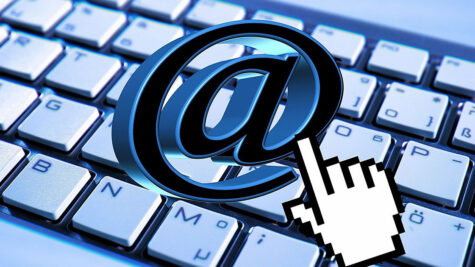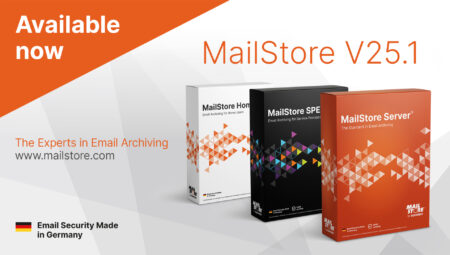
Email Through the Ages – From the Beginnings to its Importance Today
Much of what used to be communicated verbally, by fax, or hand-written note is now sent by email. The advantages are obvious: an email can be written quickly, it reaches the recipient or several recipients immediately and simultaneously, and takes up much less space than paper-based communication. Issues with global time zones (a problem with conventional telephony) or lengthy dispatch times for mail sent via postal systems are now a thing of the past and have been for some time. Recipients also benefit because they can save emails and the information they contain to folders in a structure of their choosing. Over time, a knowledge base emerges that is both easy to navigate and serves as a valuable information resource.
Emails are part and parcel of everyday life and have been an indispensable element of business life for decades. But when did the email arrive on the scene? Let’s take a short journey back in time to see how it all started.
The First Email – How It All Began
The first email was sent in 1971 by U.S. programmer Ray Tomlinson (born 23 April, 1941, died 5 March, 2016). While employed by the research company Bolt, Beranek and Newman (BBN), he developed a program called SNDMSG (“send message”) for sending messages to different computers connected to ARPANET. In fact, Tomlinson had in earlier times worked on a protocol called CPYNET that allowed files to be transferred between computers.
ARPANET – Precursor of the Internet
ARPANET (the Advanced Research Projects Agency Network) was a computer network operated across telephone lines. In around 1968, it was developed by a group of researchers at the Massachusetts Institute of Technology and the U.S. Department of Defense. The client, the U.S. Air Force, was interested in networking all the universities conducting research for the Department of Defense at the time. The idea was for the universities to exchange data with each other via the network. ARPANET was operated by the Defense Communications Agency (DCA), known today as the Defense Information Systems Agency (DISA). During the 1980s, ARPANET evolved to become the Internet.
Tomlinson managed to send his email between two computers connected by a network cable three meters in length. Some sources claim that Tomlinson could not recall the actual content of his first message, while others state that this first missive merely announced that it was now possible to send messages on the network using his method. To define the addressee, Tomlinson used the recipient’s user name and computer name separated by the @ sign. The @ sign was chosen randomly. Tomlinson was looking for a special character that was not used – or hardly used – by the developers and programmers of the day. Incidentally, the first email addresses did not have extensions such as “.com” or “.net” as there was simply no need for them.
What we know today as the @ sign predates the email by some time. As we’ve already seen, the choice of the @ sign for use in email addresses was purely coincidental: Ray Tomlinson was simply looking for a special character seldom used by programmers. But where does the @ sign come from?
In typography, the @ character is known as a ligature, a special character that combines two or sometimes three characters into a single symbol. More precisely, @ is a compound of the letters a and d as used by merchants of old to abbreviate the spelling of the Latin word “ad”, which translates as “at” and is used to denote the “price per item” of a certain good. For instance: 3 apples @ (at) 30 cents (each).
In 1880, the symbol was incorporated in typewriter keyboards. Since the first computer keyboards were based on the typewriter keyboard, the @ sign was incorporated in the world of IT.
The ability to send a message from one computer to another was a major a breakthrough in digital communications. Prior to that, it had only been possible to leave a message for a work colleague on one and the same computer. It should be remembered, however, that at the time not every programmer had his/her own computer. Computers were very expensive and very large machines, and employees often time-shared a computer via separate accounts. However, the research team is said to have been unimpressed by this success and did not initially pursue the development further as “sending messages in a network” was not considered an important motivation in terms of research goals. All that changed when the government agency DARPA (Defense Advanced Research Projects Agency), together with the above-mentioned DISA (part of the U.S. Department of Defense), got wind of it. DARPA immediately recognized the benefits and used email communications from then on. The ball was rolling.
Milestones in Early Email History
 It’s now over 50 years since the email was invented. Who would have thought back then that this invention would be so huge and ultimately become the No. 1 communication channel, particularly in the business environment? Here are some milestones from the early days of the email.
It’s now over 50 years since the email was invented. Who would have thought back then that this invention would be so huge and ultimately become the No. 1 communication channel, particularly in the business environment? Here are some milestones from the early days of the email.
- 1971: Ray Tomlinson sends the first email.
- 1973: The first email standard, with functions such as “from”, “to” and “forward” is developed.
- 1974: Bolt, Beranek and Newman (Tomlinson’s company) releases Telenet, a commercial version of the ARPANET computer network.
- 1976: Queen Elizabeth II becomes the first head of state to send an email (from ARPANET) during a visit to the British Royal Signals and Radar Establishment.
- 1978: Gary Thuerk, a marketing employee at Digital Equipment Corporation, sends an email to around 400 recipients via ARPANET. The email contains an invitation to a presentation event for the new DECSYSTEM-2020, 2020T, 2060 and 2060T computer systems. This message is reckoned to be the first spam email in history.
- 1984: Germany receives its first email. At 10:14 CET on 3 August, 1984, Michael Rotert at the University of Karlsruhe receives an email from Laura Breeden in Cambridge, Massachusetts, sent via the U.S. SNET platform (Computer Science Network). The email contained the message: Welcome to CSNET! Michael, this is your official welcome to CSNET.
Rapid Developments in IT Drive the Popularity of the Email
 The rapid development of computer technology in the 1980s and 1990s fueled the popularity of the email. The advantages of digital data processing and networking had already been recognized in the 1970s. But at that time, computers were only to be found in universities and research facilities due to their size and immense cost. Not until the arrival of small, powerful and affordable personal computers in the early 1980s did an increasing number of companies around the globe finally venture into the digital age. The early 1990s also saw the Internet made publicly available for commercial use. A little later, the first free, graphics-capable web browser appeared on the market.
The rapid development of computer technology in the 1980s and 1990s fueled the popularity of the email. The advantages of digital data processing and networking had already been recognized in the 1970s. But at that time, computers were only to be found in universities and research facilities due to their size and immense cost. Not until the arrival of small, powerful and affordable personal computers in the early 1980s did an increasing number of companies around the globe finally venture into the digital age. The early 1990s also saw the Internet made publicly available for commercial use. A little later, the first free, graphics-capable web browser appeared on the market.
Today, emails are an integral part of daily life, whether in business or in private life. According to Statista (citing the Radicati Group: Email Statistics Report, 2022-2026), approximately 347.3 billion emails will be sent and received worldwide this year. The U.S. online recruitment service Zippia Inc. and the online marketing platform OMT have listed more interesting statistics on the use and popularity of emails. Read the original articles here and here (in German). Below are some of the latest key figures mentioned in the articles:
- There are approximately 4.3 billion email users worldwide
- More than 60% of all emails are opened on mobile devices
- The average “open rate” across all industries is 17.61%, with a click-through rate of 8.74% and a bounce rate of 10.64%
- More than 90% of people between 15 and 64 use email
- 75% of all employees prefer email as a means of communication
According to Statista, the volume of email traffic is set to increase further in the coming years (376.4 billion emails in 2025). The email remains the No. 1 means of communication for a variety of reasons. The email enjoys global acceptance as a decentralized service that is simple, affordable and freely available (users can even run their own mail servers, if they like). As a rule, an email address is required to log into online stores or online platforms. Newsletters and transactional emails are part of daily (digital) life. And even though emails, too, are often the target of cybercrime in the form of phishing, the German study “E-Mail für Dich 2.0” (“Email for You 2.0”) found that emails continue to be regarded as a reliable and – in contrast to social media or instant messaging channels – trusted means of communication. Moreover, emails can play an important role in eDiscovery processes (eDiscovery Processes and Business Emails: What You Need to Know).
Alternative Channels of Communication
In the meantime, new alternative forms of communication such as messenger services and collaboration platforms are gaining in traction. That being said, the email is not being squeezed out of the picture either. It is more the case that certain forms of communication are being moved onto alternative channels that are considered more suitable. After all, the email is not a project management or social collaboration tool. Nor is it suitable for in-house, dialog-oriented communication (although it is often misused for this purpose).
Due to the growth in popularity of the smartphone, communication has shifted to messenger services such as WhatsApp, especially in the personal sphere, as these tools are optimized for mobile use and are better suited for everyday chit-chat. At home – as mentioned briefly above – email accounts are used predominantly for accessing online stores, receiving transactional emails and newsletters, and for composing messages of an “official” nature, e.g. interaction with public agencies, insurance companies, and the like.
In the business world, too, alternative communication channels are increasingly being used to deal with specific matters. Collaboration platforms such as Microsoft Teams offer chat functions and digital telephony as a quick and informal way for employees to deal with minor everyday matters. Similarly, online meetings can be conducted and documents worked on jointly without documents having to be sent to each individual employee. As working practices become more decentralized, a process that used to necessitate a visit to a colleague’s office or the meeting room can now take place digitally using collaboration software.
The Bottom Line
It remains to be seen how important email will be in the future. At the moment, due to its official character and the importance of having a well-documented form of communication, it remains the No. 1 means of communication, especially in the business environment, and will remain so for the foreseeable future. And what then?
Alongside the increasingly popular collaboration platforms and messenger services, which are all useful supplements to email, growth in virtual reality is making rapid progress. What options for communication will this open up? Virtual offices, avatar employees sitting in virtual offices and moving around freely to meet other avatar employees in virtual meeting rooms, for example? The imagination knows no limits. But until such technology attains market maturity and has been scrutinized by the legislator, we will probably continue opening our mailboxes every morning and be delighted (or vexed) by newsletters, spam mail, reply-alls, and the really important messages.
Do you want to secure your emails in the long term, keep them available and search them? Then take a closer look at the topic “email archiving”. In this article you will learn about the advantages of email archiving. For IT managers in companies, we have also created an overview for IT decision-makers.





